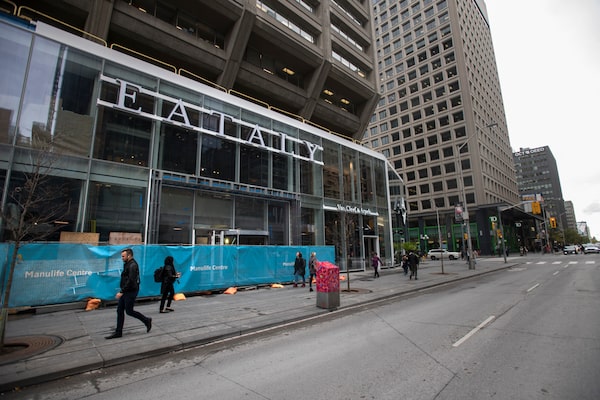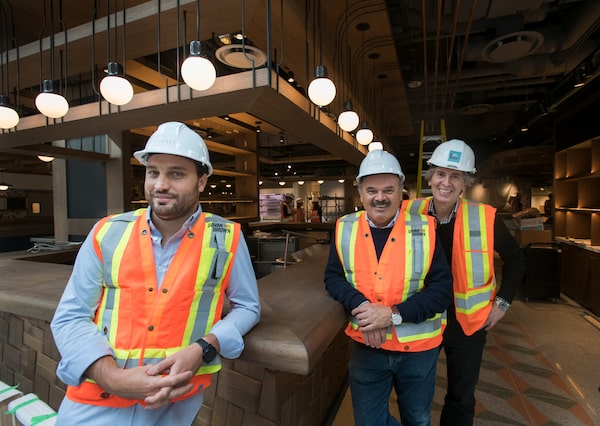
Eataly's 40th location at the Manulife Center on Bloor St. West, will open its doors for food lovers on Nov. 13, 2019.Fred Lum
Seventeen years ago, Oscar Farinetti sketched out an idea for a grocery store on a piece of paper. Along the periphery of the simple rectangle were counters for meat, fish, cheese, wine and bread, and strategically peppered through the centre were stations serving freshly-made pizzas, seafood and traditional Italian fare. “Eat Italy” was scrawled along the bottom of the page. Farinetti, who made his fortune with a chain of Italian big-box electronics stores, is passionate about food and wine, and as he surveyed the global offerings of popular chains such as Starbucks and Pizza Hut, he noticed that something important was missing.
“In every part of the world people want to eat Italian food,” Farinetti says. “I asked myself, ‘Why doesn’t there exist an Italian chain of restaurants and markets that sells real Italian food?’ It was necessary!” Five years later, in 2007, in a renovated vermouth factory in Turin, Eataly was born.
To consider what Farinetti’s simple idea has since become, with locations from Tokyo to Moscow, Las Vegas to – as of Nov. 13 – Toronto, is to gain an appreciation for the appeal of pasta, Parmigiano Reggiano and olive oil. It also reveals the changing nature of how people in cities around the world want to shop and eat.
Eataly finally arrives in Toronto: ‘It’s important that we do it right instead of fast’
“The advantage of the Italian kitchen is that it’s replicable,” says Farinetti, who is in Toronto a few weeks before doors open to oversee the final phase of construction of Eataly’s 40th location, a sprawling 50,000-square-foot, three-storey space in Toronto’s Manulife Centre. Wearing a hard hat and orange safety vest, Farinetti strolls among the construction debris, cheerfully pointing out empty shelves that will soon be filled with all of his favourite ingredients for Italian home cooking: dried porcini mushrooms from Umbria, balsamic vinegar from Modena, organic canned tomatoes from Campania. “Our cuisine was invented at home by our great great-grandmothers,” he says. “It’s very simple.”

Oscar Farinetti, founder of Eataly, is in Toronto for a few weeks to oversee the final phase of construction.Fred Lum
As with every other location of Eataly’s growing empire, Toronto’s outpost will combine the best attributes of a high-end Italian grocery store with a piazza’s worth of bars, restaurants and cafés. Customers can buy a glass of prosecco from a walk-up bar, sip it while they peruse the grocery shelves and then have a nice piece of branzino grilled to order from the seafood counter and served to them tableside. They can browse the three stations making three different regional styles of pizza or simply order from the menu at one of Eataly’s four full-service restaurants. For dessert, gelato is made in-house daily using seasonal ingredients, hazelnut creme is made from scratch and cannoli are filled to order.
Eataly’s grocery offerings, meanwhile, come largely from small artisanal suppliers chosen for their attention to quality and regional culinary tradition – a distinction the company takes every opportunity to promote. Afeltra pasta, one of Eataly’s most popular products, is made by a 170-year old company in Gragnano using traditional bronze dies and spring water from the Lattari Mountains and is air-dried for up to two days. Customer education continues at La Scuola di Eataly, an in-house cooking school where customers can learn how to make fresh pasta and gnocchi, and learn to appreciate the difference between a barolo and a barbaresco. There are even “Eatalian Walking Tours,” which educate customers on the makings of fresh mozzarella and focaccia during a guided walk through the store, samples included. Just as you might book a foodie walking tour on your vacation in Rome, so too can you stroll the aisles at your local Eataly.
All of this seems tailor-made for a certain kind of over-scheduled, culturally savvy urban professional, a customer who will happily spend a little more on groceries in exchange for being able to drink wine while they shop. “One thing they do very well is make the store experience fun,” says Claire I. Tsai, associate professor of marketing at the University of Toronto’s Rotman School of Management. Tsai compares shopping for food at Eataly to shopping for furniture at IKEA, a tiresome chore transformed into a fun family outing thanks to clever merchandising and, of course, food. “When people go to IKEA they can spend a day there,” she says. “And Eataly is similar, with their displays, with sampling, it’s all very nicely done. It’s not like going into Loblaws or other stores where the shopping experience is more utilitarian.”

Nicola Farinetti, left, CEO of Eataly North America, Oscar Farinetti, centre, and Tony Grossi, president of Wittington Properties, at the Eataly construction site.Fred Lum
The IKEA comparison is one that Farinetti welcomes; the two brands actually share adjoining retail spaces at Eataly Rome. “Why do so many people all over the world like to go to IKEA?” he asks rhetorically. “It’s a big store where it’s possible to buy good products with not many high prices. It’s possible to go with your family, to eat, to play, to learn and to solve a problem. At IKEA it’s for the house, at Eataly it’s for the body.”
While Eataly began as a place to shop for ingredients and maybe have a light meal, Farinetti’s original concept has evolved in recent years to cater to the growing number of customers who’d rather skip cooking altogether. According to a 2017 study conducted by Dalhousie University, 42 per cent of Canadians say they don’t have time to cook during the week, a trend that has accompanied the rise of both takeout apps and upscale food halls. “All grocers now realize that this is not about selling a product any longer, it’s about capturing share-of-stomach from Uber Eats and Skip the Dishes,” says Myles Gooding, national retail and consumer lead at PricewaterhouseCoopers Canada. “Eataly speaks to the busy consumer who wants a high-quality product and service, but is time-starved.”
To meet this need, Toronto’s Eataly will offer the largest selection of grab-and-go meals of any location so far, and eventually the option to order via third-party delivery app. It’s something of a sore point to Farinetti, whose vision remains to spread the gospel of Italian home-cooking to the four corners of the earth. “We want to convince families that it will be good to spend some time around the table, to speak about the day, to have some spaghetti and prosciutto,” he says. “I want to teach people how in 10 minutes it’s possible to prepare one dish of spaghetti pomodoro – fantastic – in 10 minutes!” Someday, perhaps. In the meantime, it can be delivered to your door.
Plan your weekend with our Good Taste newsletter, offering wine advice and reviews, recipes, restaurant news and more. Sign up today.
Editor’s note: An earlier version of this article incorrectly stated that the Toronto store is Eataly's 41st location. In fact, it is the 40th.